HP Spectre x360 13 review: A high-end two-in-one that’s hard to beat

Enlarge / It is sleek. (credit: Valentina Palladino)
There was a lot to love about the 4th-generation HP Spectre x360 13, but HP wasn't satisfied. The new 5th-gen laptop, which debuted at the end of 2019, has more improvements than you'd think just by glancing at it. in fact without inspecting it thoroughly, you may think the new Spectre x360 13 looks and feels just like the previous model. But fear not, it's different-HP significantly shrank the device, added a mic-mute button, gave it optional LTE support, and stuffed 10th-gen Ice Lake Intel processors inside of it.
When OEMs make improvements and try to fix problems on a laptop, they often have to make sacrifices. With thin-and-light flagships like these, sacrifices typically come in power, battery life, and port selection, just to name a few areas. But HP didn't remove anything from the 4th-generation laptop when making the newest model-a fact that will work in its favor as it has to compete with the likes of the Dell XPS 13 two-in-one and the new Dell XPS 13 laptop. But just how much better did HP make the Spectre x360 13, and are there any hidden negatives about the newest iteration? We recently spent a few days with the laptop to find out.
Look and feel| Specs at a glance: HP Spectre x360 13 (2019, as reviewed) | |
|---|---|
| Screen | 13.3-inch FHD (1920 x1080) WLED touchscreen |
| OS | Windows 10 |
| CPU | Intel Core i7-1065G7 (Ice Lake) |
| RAM | 8GB |
| Storage | 512GB PCIe SSD + 32GB Optane Memory |
| GPU | Intel Iris Plus Graphics |
| Networking | Intel Wi-Fi 6 AX 201 (2x2), Bluetooth 5 |
| Ports | 2 x Thunderbolt 3, 1 x USB-A, 1 x microSD card, 1 x headphone jack |
| Size | 12.1i-7.7i-0.7 inches |
| Weight | 2.88 pounds |
| Battery | 60Whr 4-cell |
| Starting price | $1,099.99 |
| Price as reviewed | $1,299.99 |
| Extras | Camera kill switch, mic-mute button, optional LTE, active pen included |
 HP Spectre x360 13 Starting at $1,099.99 from HP (Ars Technica may earn compensation for sales from links on this post through affiliate programs.)
HP Spectre x360 13 Starting at $1,099.99 from HP (Ars Technica may earn compensation for sales from links on this post through affiliate programs.) If you spend an inordinate amount of time around laptops like I do, the new narrowness to the 5th-gen HP Spectre x360 13 would immediately strike you. The previous model had chunky black bezels at the top and bottom of its display, increasing the overall width of the device. HP slashed most of that unnecessary space here, leaving behind a modest bezel at the bottom of the display with the HP logo on it. The company developed a super-tiny (2.2mm) IR camera as well, so it could keep that form of Windows Hello on the shrunken top bezel.
Read 17 remaining paragraphs | Comments